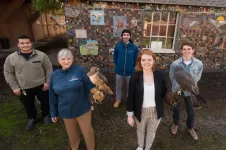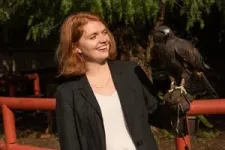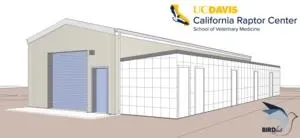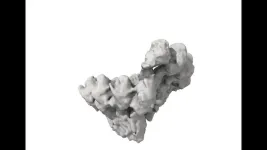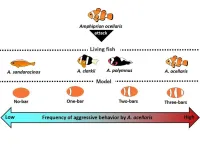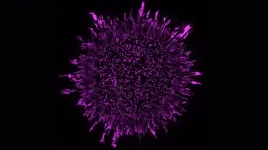(Press-News.org) Researching how bird flight can inform aircraft design is the goal of a new center to be established at the University of California, Davis.
Christina Harvey, an assistant professor of mechanical and aerospace engineering at UC Davis, and Michelle Hawkins, a professor in the School of Veterinary Medicine and director of the California Raptor Center, are launching the bird flight research center with a nearly $3 million grant from the Department of Defense. The new center will utilize motion capture and photogrammetry — which uses photography to determine the distance between objects — technologies to image birds in flight and create 3D models of the wing shapes to inform the design and capabilities of the next generation of uncrewed aerial systems, or UAS. The center will be the first of its kind in the country.
Harvey and Hawkins anticipate that by gleaning information about how different types of birds maneuver around complex environments, they can inform the development of next-generation drones and other uncrewed aerial systems to deliver packages, detect and fight wildfires, and more.
“Michelle Hawkins and the California Raptor Center were a big reason I came to UC Davis,” said Harvey, who is trained in both zoology and engineering and joined the Department of Mechanical and Aerospace Engineering in 2022. “I can be running wind tunnel experiments [on the UC Davis campus], and then in 15 minutes, go and work with the birds directly at the CRC.”
The facility is currently in the planning stages, with the goal to break ground at the raptor center this fall. It will comprise a covered, prefabricated barn that will serve as an indoor hall in which the birds can fly and maneuver. Infrared and high-speed, high-resolution cameras will be installed along the hall, which will also house holding cages, called mews, to acclimate the birds to the flight area.
Imaging birds in flight
While other groups, particularly in the U.K., have used motion capture and photogrammetry separately to perform bio-informed flight research on birds, this center will be the first to pair the two to quantify how birds react and move in complex environments.
Motion capture technology uses multiple infrared cameras to track reflective markers on the moving subject. To track the bird’s movements, markers can be placed on the bird’s wings, body and tail, as well as on obstacles to assess how a bird may maneuver around each obstacle.
However, due to the sparse placement of the markers, motion capture technology cannot be used to create detailed 3D models, which are necessary for experiments in computational fluid dynamics.
Photogrammetry, on the other hand, uses specialized algorithms to combine multiple calibrated 2D camera images to create a 3D model, but the heavy data processing load requires such high-resolution imagery that the technology has only been used to model birds in steady glides.
Harvey and her team of researchers will use motion capture to trigger the photogrammetry system to take a short burst of images when the bird enters and performs a maneuver in the cameras’ fields of view.
This will enable Harvey to create 3D models of complex wing shapes and investigate fundamental research questions, such as how birds control their dynamic systems in flight and what attributes are necessary to achieve specific maneuvers. Incorporating these birdlike attributes into aircraft design could unlock a world of potential for uncrewed aerial systems, from package delivery in remote and urban areas to wildfire surveillance.
“Remember when Jeff Bezos was out there telling everybody that drones were going to put your Amazon package on your front step? Well, that maneuverability is still not available,” Hawkins said.
Harvey added: “Think of firefighting. We don’t have an aircraft that can switch between a surveillance drone like a glider and an aircraft that can weave between trees like multi-rotors. Information we glean from this research may move us closer in that direction. This research has the potential to really impact the world.”
Benefits to the birds
Throughout her career in veterinary medicine, Hawkins hadn’t ever really considered a partnership with an aerospace engineer until Harvey requested to meet.
“When Christina got in contact with me last year, I thought, ‘You’re coming to interview, and you want to meet with me?’ It didn’t make a lot of sense, but I was absolutely curious about it,” she said. “This is so far beyond the bell curve of veterinary medicine as I knew it, and I thought I was as far out on the bell curve as there was, being a bird specialist.”
Hawkins views the new facility as a win-win for Harvey and the raptor center. Harvey will have direct access to the birds in rehabilitation who can fly, while other flight-research facilities typically outsource their birds from falconries. The birds, including turkey vultures, a peregrine falcon, a kestrel, a barn owl, kites and a red-tailed hawk named Jack, will be trained to fly down the facility’s hallway and land on a perch, getting exercise that will help with their rehabilitation and longevity.
Hawkins plans to use the imagery and modeling of the birds in flight to see where their deficits are and where to target rehabilitation efforts. She also anticipates incorporating the technology into her teaching to train the next generation of veterinarians, comparing the videos of birds in flight to the birds’ X-rays and CT scans.
“We’ll be able to do much more with the equipment available because it’s going to be so state of the art,” she said.
Laying the research foundation
Harvey already has research initiatives in the pipeline, so she and her team are fully prepared once the walls go up. Alfonso Martinez, a postdoctoral researcher in her lab, is set to begin the initial studies with some of the cameras in March to become familiar with the equipment and start collecting data. A master’s student, Francisco Jackson, has been dissecting bird cadavers to investigate wrist movements, providing possible ranges of movement, which will then be observed and juxtaposed with what the birds are doing in flight.
For Harvey, it’s the beginning of what she envisioned was possible when she first considered UC Davis.
“This partnership isn’t something that you would find anywhere else and that’s really exciting for all of us collaborating on this project.”
END
UC Davis establishes bird flight research center
Unique facility will image birds of prey in flight to model uncrewed aerial systems
2024-02-01
ELSE PRESS RELEASES FROM THIS DATE:
ADA releases updated recommendations to enhance radiography safety in dentistry
2024-02-01
CHICAGO, Feb. 1, 2024 – The use of lead abdominal aprons or thyroid collars on patients when conducting dental X-rays is no longer recommended, according to an expert panel established by the American Dental Association (ADA) Council on Scientific Affairs. Additionally, dentists should take into consideration the diagnostic information needed from X-rays to benefit patient care or substantially improve clinical outcomes.
The Journal of the American Dental Association published the new recommendations today, which aim to improve radiation ...
Cheating death: How cancer cells escape
2024-02-01
Cell death is fundamental to life and, thus, healthy aging. In the realm of cellular biology, ferroptosis (a form of programmed cell death) has emerged not only as a focal point of research for its potential in eliminating cancer cells, but also its role in a plethora of other diseases, including neurodegenerative diseases such as Alzheimer’s disease, eye diseases such as Retinitis pigmentosa and age-related macular degeneration, as well as ischemia, cardiovascular disease, liver disease, acute kidney injury and inflammation.
While studies of other forms of cell death such as apoptosis focus largely on ...
JMIR Medical Informatics invites submissions on AI language models in health care
2024-02-01
JMIR Publications is pleased to announce a new section titled, “AI Language Models in Health Care” in JMIR Medical Informatics. This leading peer-reviewed journal is indexed in PubMed and has a unique focus on clinical informatics and the digitization of care processes. This section will have a broad focus and encompass topics about the successful implementation of artificial intelligence (AI) language models in diverse health care settings. The topics will include details about the process, use, outcomes, and ...
Human cells building ‘molecular highways’ captured for first time
2024-02-01
Researchers at the Centre for Genomic Regulation (CRG) in Barcelona and the Spanish National Cancer Research Centre (CNIO) in Madrid have captured the world’s first high-resolution images of the earliest moments of microtubule formation inside human cells. The findings, published today in the journal Science, lay the foundations for potential breakthroughs in treating many different types of diseases ranging from cancer to neurodevelopmental disorders.
“Microtubules are critical components of cells, but all the images we see in textbooks describing the first moments of their creation are models or cartoons based ...
Clown anemonefish seem to be counting bars and laying down the law
2024-02-01
We often think of fish as carefree swimmers in the ocean, reacting to the world around them without much forethought. However, new research from the Okinawa Institute of Science and Technology (OIST) suggests that our marine cousins may be more cognizant than we credit them for.
By observing how a colony of clown anemonefish (Amphiprion ocellaris) – the species of the titular character in Finding Nemo – reacts to intruders in their sea anemone home, OIST researchers have found that ...
New research shows that the arrangement of bacteria in biofilms affects their sensitivity to antibiotics
2024-02-01
Bacteria are traditionally imagined as single-cell organisms, spread out sparsely over surfaces or suspended in liquids, but in many environments the true bacterial mode of growth is in sticky clusters called biofilms. Biofilm formation can be useful to humans—it is integral, for example, to the production of kombucha tea. But it is more often problematic, because it makes it more difficult to control bacterial growth: When bacterial cells produce a biofilm, it acts as a shield against outside invaders, making the bacteria more ...
First atomic-scale 'movie' of microtubules under construction, a key process for cell division
2024-02-01
· Researchers at the Centre for Genomic Regulation (CRG) , the Spanish National Cancer Research Center (CNIO) and the IBMB-CSIC solve a key problem in biology: how human cells build their microtubules
· During cell division, microtubules function as nanometer-thick long ‘ropes' inside cells that pull chromosomes apart so that each daughter cell receives a copy of the genetic material
· The work published in Science lays the groundwork for future breakthroughs in the treatment of diseases ranging from cancer to neurodevelopmental disorders
Cells in the human body are constantly dividing. With each division the genetic information contained in the ...
Mapping the structure and organization of hippocampal neurons in the mouse brain
2024-02-01
Single-cell projectome analysis has revealed previously unknown spatial organization principles of the brain-wide structure and connectivity of more than 10,000 individual hippocampal neurons in the mouse brain, according to a new study. Specialized projections called axons allow neurons to transmit signals to other neurons across the brain. The hippocampus (HIP) – one of the most extensively studied brain regions – plays a crucial role in many crucial brain functions, including learning, memory, ...
Large herbivores’ effects on ecosystems depend more on size and diet than on herbivore origin
2024-02-01
The effect of large herbivores on plant abundance and diversity depends more on their size and diet than whether they are native or introduced into their host ecosystems, according to a meta-analysis of more than 200 studies worldwide. The findings counter the widely held notion that the impacts of introduced megafauna are distinct and more harmful than those of native megafauna and suggest that trait-based ecology provides better insight into megaherbivore-plant interactions than concepts of species origin. Large mammal herbivores play a key role in shaping ecosystems and biodiversity by consuming vegetation, dispersing seeds and nutrients, and creating ...
The evolution of sign languages globally revealed through computational analyses
2024-02-01
A computational analysis has highlighted the poorly understood relationships and elusive histories of modern sign languages worldwide, revealing two major sign language families shaped by geopolitical forces and relevant signing communities. The findings show that the computational methods applied – which have been useful in understanding spoken languages – can be extended to the study of sign languages; as such, they offer promise for addressing the disparities in our understanding of other marginalized and diverse ...
LAST 30 PRESS RELEASES:
Numbers in our sights affect how we perceive space
SIMJ announces global collaborative book project in commemoration of its 75th anniversary
Air pollution exposure and birth weight
Obstructive sleep apnea risk and mental health conditions among older adults
How talking slows eye movements behind the wheel
The Ceramic Society of Japan’s Oxoate Ceramics Research Association launches new international book project
Heart-brain connection: international study reveals the role of the vagus nerve in keeping the heart young
Researchers identify Rb1 as a predictive biomarker for a new therapeutic strategy in some breast cancers
Survey reveals ethical gaps slowing AI adoption in pediatric surgery
Stimulant ADHD medications work differently than thought
AI overestimates how smart people are, according to HSE economists
HSE researchers create genome-wide map of quadruplexes
Scientists boost cell "powerhouses" to burn more calories
Automatic label checking: The missing step in making reliable medical AI
Low daily alcohol intake linked to 50% heightened mouth cancer risk in India
American Meteorological Society announces Rick Spinrad as 2026 President-Elect
Biomass-based carbon capture spotlighted in newly released global climate webinar recording
Illuminating invisible nano pollutants: advanced bioimaging tracks the full journey of emerging nanoscale contaminants in living systems
How does age affect recovery from spinal cord injury?
Novel AI tool offers prognosis for patients with head and neck cancer
Fathers’ microplastic exposure tied to their children’s metabolic problems
Research validates laboratory model for studying high-grade serous ovarian cancer
SIR 2026 delivers transformative breakthroughs in minimally invasive medicine to improve patient care
Stem Cell Reports most downloaded papers of 2025 highlight the breadth and impact of stem cell research
Oxford-led study estimates NHS spends around 3% of its primary and secondary care budget on the health impacts of heat and cold in England
A researcher’s long quest leads to a smart composite breakthrough
Urban wild bees act as “microbial sensors” of city health.
New study finds where you live affects recovery after a hip fracture
Forecasting the impact of fully automated vehicle adoption on US road traffic injuries
Alcohol-related hospitalizations from 2016 to 2022
[Press-News.org] UC Davis establishes bird flight research centerUnique facility will image birds of prey in flight to model uncrewed aerial systems
